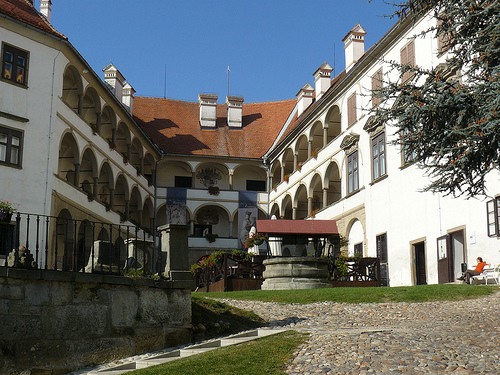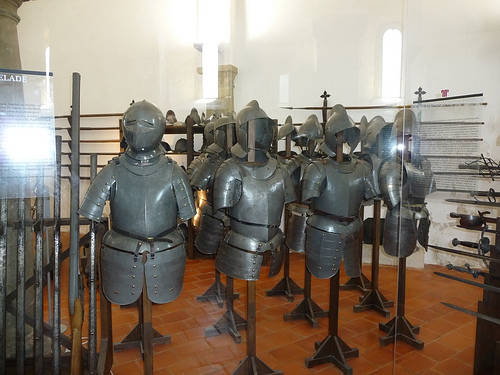

Location: Ptuj, Lower Styria Map
Constructed: 12th century
Tel. 02 748 0360
Entrance Fee: €3
Open: May- mid- Oct 9am- 6pm
Mid- Oct- Apr 9am - 5pm

Ptuj Castle is a medieval citadel in the Ptuj, Lower Styria region of the North- east region of Slovenia. Ptuj Castle was constructed on a strategic hill overlooking the city below in the 12th century with money provided by the Archdiocese of Salzburg. Its purpose was to defend these lands against possible intrusions by Hungarians. Although today only West Tower is all that remains from the original medieval stronghold. Today the citadel is open to the public. It contains a small museum devoted to the castle's history as well as several tombs of its former owners. Best visible is that of Frederick IX near museum.

History
Objects found on the castle hill have been evidence of continuous
settlement since the early Stone Age. Around 1000 BC a fortification
was fortified on the castle hill, as evidenced by the intact
settlement walls. In the younger Iron Age, it was the time of the
migration of the Celts to the east, which also left behind some
remains (graves). The prehistoric settlement was replaced by Roman
forts, followed by late antique sanctuary, followed by
early-medieval Old Slavic fortification and burial ground. In the
9th century, the defense tower of the Church of Our Lady of Salzburg
was located here.
The oldest written sources mention that Archbishop Konrad I of
Salzburg gave it , which was in this position from 1106 to 1147, to
build a fort on the site of the remains of older medieval buildings
in the years 1125 to 1130. was bombed in borock or. the second half
of the 17th century. Around 1220, Archbishop Eberhard II of
Salzburg. and the Duke of Styria Leopold VI. set up a mint of money
allegedly in a castle near the Roman palace and the Konrad Tower.
The mint ceased to operate in 1230. From 1235, the Herman knight of
Ptuj is mentioned, and in the same century several other references
to objects connected with Ptuj were mentioned. In 1247 a "small"
castrum (castrum minus) is mentioned, suggesting that a large
castrum ("castrum maius") also existed. In 1260, the caste was
mentioned(pro custodia castri), which would amount to 200 marks.
Around 1376, two castles ( beide burg und stet ) are mentioned in an
anonymous chronicle . In 1433, the Ptuj mansions Hartnid and
Frederick write about the Salzburg feud in Ptuj: the castle, the
castle tower, the castle hills and 12 guard estates around it. The
last medieval record of the Ptuj castle dates from 1487, in the
travel diary of Paolo Santonin, the companion of the Aquileian
visitor. It is recorded that the castle is solid and invincible.
The castle of Ptuj was very important in the Middle Ages. It was the
center of the feudal estate of the Church of Salzburg in Podravje,
the gentlemen of Ptuj and its good strategic location. Apart from
Stubenberg and Wildon, the castle of Ptuj is the only one in Styria
at the time, which had to provide, if necessary, a provincial
defense of 200 armed men.
The feudal owners of the castle were the gentlemen of Ptuj . The
first of these dates from 1137 (until 1161) to Frederick I -
Friderich de Bethowe. In 1161 to 1178 Frederick II. - Friderich de
Pettove, Frederick III. - Friderich puer de Petowe from 1180 to
1222. In the 13th century Ptuj was fortified with walls and the
castle complex has a typical three-part design: western and eastern
castle plateau (suburbs), cvinger , central courtyard with fountain
, palaces , bergfried and several side buildings. After the death of
Frederick IX in 1438 , the Ptuj family became extinct, followed by
the Stubenbergs. From 1480 until 1490 Ptuj and the castle were in
Hungarian hands. property of Matthias Corvinus, in 1490 the occupied
territory was taken over by the German emperor Maximilian as a
princely estate owned by various tenants. It kept the town and the
castle until 1511, when the castle and the town of Ptuj were pledged
to the Archbishop Lenart Hhodisky of Salzburg, who began renovating
it because it was in poor condition. In 1555 the archbishop left the
estate to Emperor Ferdinand I and remained in their possession until
1622 when it was purchased by the Eggenberg family . In 1634 the
property was sold to the Thaunhausen family , who in 1642 donated it
to the Jesuits of Zagreb . Due to financial distress, the Jesuit
castle was sold in 1656 to General Walter Leslie pl. Balquhane,
Scottish by birth. This castle was thoroughly overlooked, since
during the Baroque period and the end of the Turkish invasions, the
castle lost its defensive character. He turned it into a rural
residence and the headquarters of a landlord. His descendants owned
it until 1802, after their extinction, the estate was inherited by
the Dietrichstein relatives , but they became extinct in 1864. After
the hereditary complications, it was bought in 1873 by the Countess
Theresa Herberstein , the firstborn of the last Duke of
Dietrichstein, and thus saved from collapse, and reconstructed and
re-equipped. It remained in their possession until 1945, when it was
nationalized. It now houses the cultural and historical collection
of the Ptuj Provincial Museum . In 1999, the castle was declared a
cultural monument of national importance.
When, in 1555, the castle again fell into the hands of the princely
hands, it began to be thoroughly restored and consolidated. From
that time is also the famous entrance portal, the work of the
Italian architect Giovanni Peruzzi (1511 / 12-1572), the son of
architect Baldassare Peruzzi of Siena. About Renaissance rebuilding
the castle are preserved other reports, among others, bear witness
to the emergence of the retaining wall where the hill crashed.
The castle was repeatedly upgraded or modified,
the Gothic remains of the little (for example, a helical staircase),
the last major construction work has begun Leslie at the end of the
17th century , when the reconstructed Romanesque palatial and newly
built northeast of the castle wing. The castle was given today a
triangular design. The most prominent castle rooms were arranged in
both tracts. In the south, they are decorated with rich ceiling
stucco, and in the north, the knight's hall and chapel rise through
two floors. The castle complex was also erected in the 18th century,
when the southern triaxial extension for the castle administration
was added to the Charles Portal and a granary granary was built.
The lords of the castle
9th c. Archdiocese of Salzburg: from 1131 to 1438 with interruptions
by the gentlemen of Ptuj, vassals of the Archdiocese of Salzburg
1258 Styrian provincial princes
1279 Frederick V. Ptujsky
1294/1286 Archdiocese of Salzburg
1479 King Matthias Corvinus of Hungary
1490 The Habsburgs as Styrian provincial princes
1512 Archdiocese of Salzburg
1555 The Habsburgs as Styrian provincial princes
1622 princes of Eggenberg
1634 Barons of Thannhausni
1642 Zagreb Jesuit Monastery
1656 Counts of Leslie
1802 the princes of Dietrichstein
1858 Imprisonment for determining heir
1869 Counts of Attems and Lambergi , 7/12 estates, Baron Leslie of
Balquhain 5/12 estates
1873 Counts of Herberstein
1945 State property
Collections
The Ptuj City is managed by the Ptuj Provincial Museum. The castle
has the following collections: musical instruments, weapons, feudal
housing culture, turquoise, carnival masks and paintings on glass.
There is also the castle gallery, the graphic cabinet of France
Mihelič and the collection of Marko Sluga.
Ground floor
On the ground floor there is a collection of musical instruments ,
which is divided into several parts or rooms and, since 2000, has a
status of national importance. These are: a collection of old
musical instruments, heritage, town musicians, musical instruments ,
town bands , a collection of musical instruments such as strings ,
string and wind instruments , keyboard instruments and a
reconstruction of the studio of Jan OELTJEN where you can find a
piano to Table German workshops JL Schiedmayer from Stuttgart
(1840-45 ).
The instrumental collection of instruments in Slovenia comprises
more than 300 instruments. They are divided into salon and string
instruments, folk and non-European instruments, as well as notes and
tools for their production. The master's workshop of Maksimiljan
Skalar was exhibited .
Also exhibited are archaeological finds such as: tibia fragments ,
pink and bony flutes and bronze bells. Reindeer bones, vessels and
jewelry we find reliefs of mythological figures with tibia and lyre
, and the whistle .
In addition to the Knights' Hall, the Romanesque palace also houses
a collection of weapons and military equipment, of five hundred
pieces and of national importance. Here you can find: military
brass, cold weapons on poles ( spears , chelbards ), especially the
works of Swiss, Austrian and German workshops, axes (famous from the
16th century with the Hungarian coat of arms and capital Z), Turkish
bow , combat pistons, spears of times farm resistors, a cannon , a
stone from the end of the 14th century., mortar , IDT. Here are the
armorfrom the second half of the 16th and early 17th centuries, as
well as lateral spikes and ax weapons ( swords , sabers, spades ,
rapiers and yatagans ). Among the firearms are hooked rifle arches ,
muskets , flint rifles. The armor of the Visconti dukes of Milan
from the end of the 15th century with etched engravings and
artificial ornamentation is an exceptional work.
First floor
On the first floor of the castle are the most beautiful castle
rooms. The ambient layout of furniture , tapestries , paintings and
small inventory represents the feudal living culture from the second
half of the 16th to the second half of the 19th century. The
exhibited items are divided into rooms such as: Leopold's Room,
Contessa's Room, Joseph's Room, Toilet Room, Web Room, Boudoir,
Dressing Room, Old Chapel, Countess's Bedroom, Countess's Lounge,
Dining Room, Count's Study Room and Cabinet and Herberstein Gallery.
This floor also houses a ceremonial hall with a collection of
turquoises and a chapel.
The turquoise collection consists of three series: the first is
portraits of princes, generals and ministers, the second contains
twelve paintings made by the engraving of the French painter Georges
se la Chappell, and the third presents the peoples of the lands of
China, America, Africa, Egypt and the Orient.
The chapel of the castle is dedicated to St. To the family. The
benches in the chapel are of 17th century walnut, marble flooring is
made of white and gray panels, the altar is made of black-peeled
pear with lime ornaments and oil paintings of St. Family and God the
Father. There are other paintings and prints in the chapel - copies
of various European artists.
Second floor
The castle gallery also houses some of the exceptional examples of
Gothic and Baroque art in Slovenia and a collection of paintings on
glass.